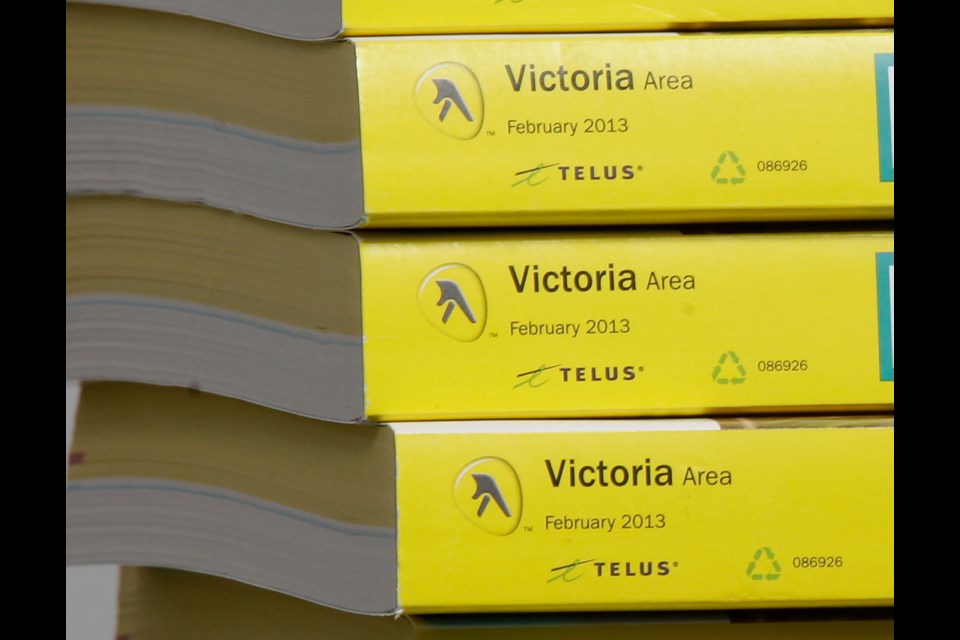It took Bruce Carter a few moments to recall the last time he cracked open the Yellow Pages telephone directory. Turns out it was probably just over two months ago that the CEO of the Greater Victoria Chamber of Commerce needed to find a listing.
For Dan Gunn of the Victoria Advanced Technology Council, it’s close to a decade since he last dug out the iconic book with the walking fingers logo.
Neither of them has a directory in their offices, though both believe there is one at reception — “somewhere.”
This is the reality for the printed version of the directory, which hit doorsteps around Victoria this month. Though it did so with less of a thump.
The change in usage that has people searching online for numbers and listings, businesses looking to advertise through other media and a reduced demand for land lines has meant the bulky, printed Yellow Pages directory is shrinking in terms of importance — and in size.
According to Fiona Story of Yellow Pages Group, the company is in the midst of a major transition.
“We have been transforming over the years to a digitally focused company, growing a lot of our products online, in mobile search, producing websites and creating videos,” she said. “Part of that is adjusting to the needs of our clients who are primarily Canada’s small and medium-sized businesses.”
That transition has seen Yellow Pages Group report nine million unduplicated unique visitors to its websites — YellowPages.ca, Canada411.ca, RedFlagDeals.com — and its mobile applications have been downloaded more than five million times.
Story said online revenue, $367 million in 2012, now represents 38 per cent of the company’s total revenues and 61 per cent of their existing clients have purchased digital products with them. So there should be little surprise that Victoria’s directory for 2013 is a shadow of its former self.
This year, it has 353 white pages, 464 yellow pages, 24 pages devoted to dialing assistance and instructions, 17 pages for provincial and municipal government listings and 10 pages for federal listings. It measures just under 2.5 centimetres in thickness.
Last year, it had 377 pages of white pages, 528 yellow pages, 24 pages devoted to Telus, 19 pages for provincial and municipal government listings and 10 pages for federal listings. It measured close to three centimetres in depth.
Story said it will get smaller still as the company is looking at reformatting the printed version.
“We will move [from] standard 9-by-11 inches and it will shrink to seven-by-nine, which is more portable and a size people are used to with iPads,” she said. “That was based on customer feedback.”
In larger centres, the Yellow Pages already have moved to making residential directories “by request” only and in other centres they offer an “opt out” program so residents can ask not to have one delivered.
But Story said they are not about to kill the directory outright. “The reality of urban markets, the suburbs and rural markets are very different, and because our market is pan-Canadian, we still have traditional media and digital media products to respond to various needs,” she said, adding printed directory usage remains “stable” with half the population using it at least once a month.
Contributing to the smaller book is the reduced demand for land lines.
According to Telus spokesman Shawn Hall, there are now 3.4 million network access lines, both business and residential, in the province, which represents a 5.2 per cent drop year over year. There has been a 7.7 per cent drop in requests for residential land lines alone in that time.
“Some people continue to make the choice to not have a land line and just go wireless. We find young people go wireless out of the gate, but they do pick up a land line later in life,” he said.
Despite that reduced demand, the province will have a new area code introduced later this year. On June 1, the 236 area code will be laid over the entire province. “It’s down to there being so much demand for phone numbers and the available supply of 604, 778 and 250 will run out in some parts of the province in the coming years. A fourth ensures lots of supply,” he said.
Hall said the new code will likely go unnoticed at first as it will be assigned to people with tablet computers or using smart cards to connect to the Internet.
B.C. split into two area codes in 1996-97 when 250 was added to 604. The 778 code was added in 2008.



